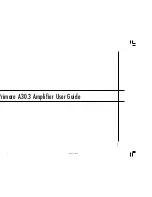
4. HARDWARE
CONNECTIONS
a. The CTA-30RK-550 is designed for installation in a standard 19” EIA rack.
b. Connect a 75ohm coaxial cable with F-connectors from the headend combiner output
to CTA-30RK-550’s Input Port.
c. Connect a 75ohm coaxial cable with F-connectors from the CTA-30RK-550’s Output
Port to the main RF distribution network.
d. Terminate the Test port with a Cabletronix F-59T terminator when not in use.
e. Connect the CTA-30RK-550 to an appropriate power source capable of powering this
device. Be certain that power source is capable of handling the load if the
CTA-30RK-550 and other equipment are being powered by it.
5. ADJUSTMENT
The chart below shows the proper operation levels for the CTA-30RK-550. Note the listed
performance criteria are for specific numbers of channels, and must be de-rated accordingly
when inserting additional channels. However, the amplifier’s gain does not change. Therefore,
as the number of channels increases from seven (7) channels, the input level and the output
level must be reduced. Exceeding the input levels listed below will product intermodulation and
picture distortion.
Number
Of Channels
Maximum
Level Input (dB)
Maximum
Level Output (dB)
7 44 66
12 41 53
36 32 54
54 16 46
Turn the CTA-30RK-550’s Gain Adjust control to achieve the input and output levels identified
above. Additional attenuators may be needed to achieve the above input and output levels.
The CTA-30RK-550’s Tilt Adjust control should be used to set the appropriate slope per system
specifications. Note that the Tilt Adjust allows the adjustment of the gain-to-frequency
characteristic of the amplifier.
When making adjustments always apply the following principles:
3
Input signal levels should ALWAYS exceed the noise figure of the amplifier by 3 to 6
dB.
3
The primary purpose of tilt (equalization) in a cable TV plant is to compensate for the
slope generated in coaxial cable between the high and low TV frequencies. When
various TV channels, with respect to frequency, are transmitted through coaxial cable
they are subjected to increasing attenuation (loss). Simply put, as the frequencies of
the TV carriers are increased, attenuation loss (dB) increases. A variable tilt control is
installed in this amplifier to compensate for this slope in cable resulting in a flat
frequency response at the output
4























